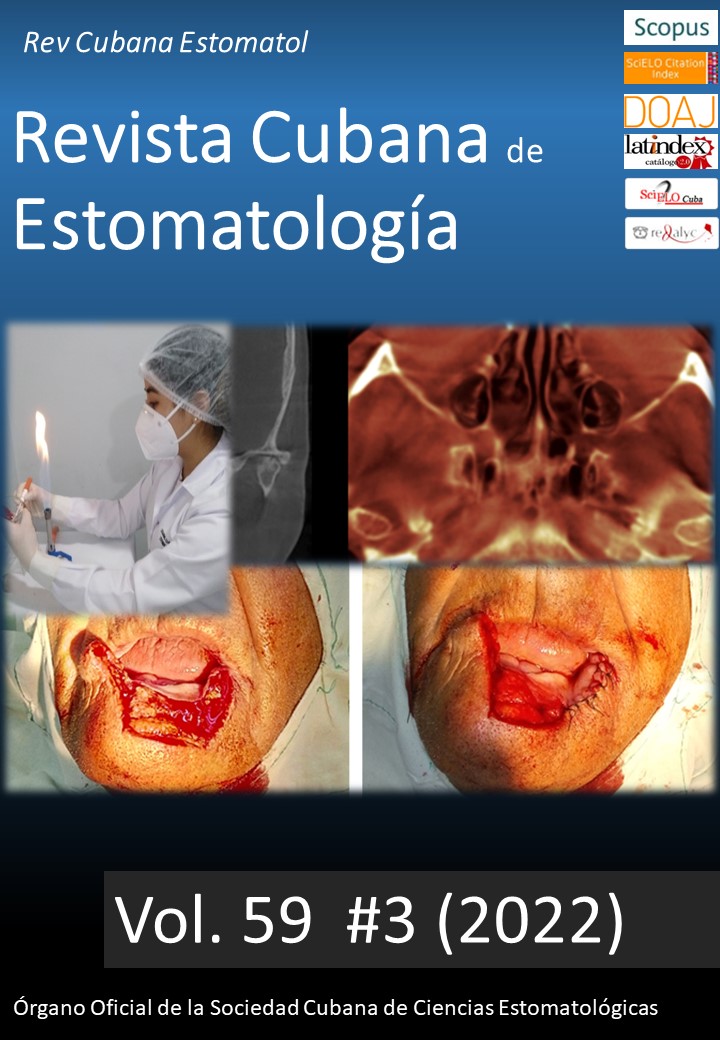Multidisciplinary treatment of total vertical excess and transverse maxillary deficiency without posterior crossbite
Keywords:
vertical excess of the maxilla, transverse maxillary deficiency, orthognathic surgery.Abstract
Introduction: The correction of the vertical excess of the maxilla will bring not only vertical changes in the profile, but also sagittal and transverse ones. The clinical absence of posterior crossbite can mask width deficiencies and lead to incorrect treatment plans.
Objective: Describe the most important aspects in the care of a case with vertical excess and transverse deficiency of the maxilla without posterior cross bite.
Case presentation: A 26-year-old female patient comes to the consultation for "teeth forward". The physical examination and the study of the diagnostic means allowed to conclude the existence of vertical excess and transverse deficiency of the maxilla. Clinically, no posterior crossbite was observed. Staged treatment included orthodontics, expansion and surgical impaction of the maxilla.
Conclusions: The surgical ascent of the maxilla should be planned based on a holistic analysis. It includes the sagittal changes of the profile and the transverse relationship between the arcades, caused by the effect of mandibular rotation. The absence of posterior crossbite does not exclude the existence of transverse maxillary deficiency. Likewise, the definitive dimension of the expansion must be established once the lower arcade reaches its definitive dimensions.
Downloads
References
Naini FB, Gill DS. Orthognathic Surgery. Principles, planing and practice. Iowa: John Wiley & Sons Ltd.; 2017.
Miloro M, Ghali GE, Larsen PE, Waite PD. Peterson´s principles of oral and maxillofacial surgery. 3 ed. Connecticut: Peoples´s Medical Publishing House-USA; 2011.
McNamaraa JA. Maxillary transverse deficiency. American Journal of Orthodontics and Dentofacial Orthopedics. 2000;117(5):567-70.
Gregoret J, Tuber E, Escobar P LH, Matos da Fonseca A. Ortodoncia y cirugía ortognática. Barcelona: ESPAXS,SA; 1997.
Rakosi T, Irmtrud J. Atlas de ortopedia maxilar: Diagnóstico. Barcelona: Ediciones científicas y técnicas SA; 1992.
Sawchuk D, Currie K, Vich ML, Palomo JM, Flores-Mir C. Diagnostic methods for assessing maxillary skeletal and dental transverse deficiencies: A systematic review. Korean journal of orthodontics. 2016;46(5):331-42.
Singaraju GS, Chembeti D, Mandava P, Reddy VK, Shetty SK, George SA. A Comparative Study of Three Types of Rapid Maxillary Expansion Devices in Surgically Assisted Maxillary Expansion: A Finite Element Study. J Int Oral Health. 2015;7(9):40-6.
Starch-Jensen T, Blæhr TL. Transverse Expansion and Stability after Segmental Le Fort I Osteotomy versus Surgically Assisted Rapid Maxillary Expansion: a Systematic Review. J Oral Maxillofac Res. 2016;7(4):e1-e.
Bazargani F, Algharbi M, Dimberg L. Do different maxillary expansion appliances influence the outcomes of the treatment? European Journal of Orthodontics. 2017;40(1):97-106.
Gürler G, Akar NK, Delilbaşı Ç, Kaçar İ. Skeletal changes following surgically assisted rapid maxillary expansion (SARME). Eur Oral Res. 2018;52(2):94-8.
Peleg O, Mijiritsky E, Manor Y, Inchingolo F, Blinder D, Mortellaro C, et al. Predictability of Mandibular Autorotation After Le Fort I Maxillary Impaction in Case of Vertical Maxillary Excess. Journal of Craniofacial Surgery. 2019;30(4):1102-4.
Venkategowda PRH, Prakash AT, Roy ET, Shetty KS, Thakkar S, Maurya R. Stability of Vertical, Horizontal and Angular Parameters Following Superior Repositioning of Maxilla by Le Fort I Osteotomy: A Cephalometric Study. J Clin Diagn Res. 2017;11(1):ZC10-ZC4.
Published
How to Cite
Issue
Section
License
Authors retain all rights to their works, which they can reproduce and distribute as long as they cite the primary source of publication.
The Rev Cubana Estomatol is subject to the Creative Commons Attribution-Non-Commercial 4.0 International License (CC BY-NC 4.0) and follows the publication model of SciELO Publishing Schema (SciELO PS) for publication in XML format.
You are free to:
- Share — copy and redistribute the material in any medium or format.
- Adapt — remix, transform, and build upon the material.
The licensor cannot revoke these freedoms as long as you follow the license terms.
Under the following terms:
Attribution — You must give appropriate credit, provide a link to the license, and indicate if changes were made. You may do so in any reasonable manner, but not in any way that suggests the licensor endorses you or your use.
- NonCommercial — You may not use the material for commercial purposes.
No additional restrictions — You may not apply legal terms or technological measures that legally restrict others from doing anything the license permits.
Notices:
- You do not have to comply with the license for elements of the material in the public domain or where your use is permitted by an applicable exception or limitation.
- No warranties are given. The license may not give you all of the permissions necessary for your intended use. For example, other rights such as publicity, privacy, or moral rights may limit how you use the material.


